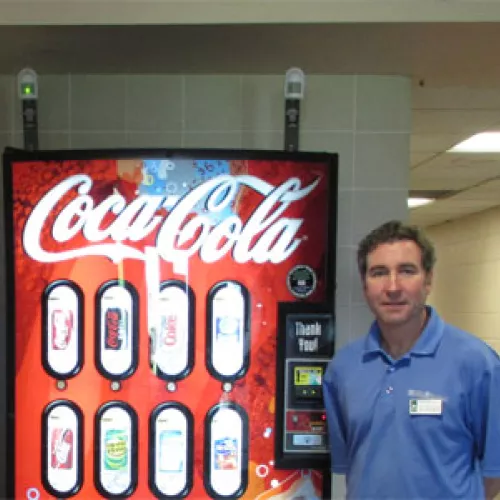Saint Paul Energy Coordinator Jim Giebel knows the importance of saving energy for a city government. He oversees the energy usage of over 160 city facilities in Saint Paul, with 3.2 million square feet of space whose collective energy costs total around $8.5 million annually. Therefore Giebel is always looking for opportunities to save the city money, which he says “in these times of tight budgets is not just nice, it’s necessary.”
When Giebel heard about a campaign that CERTs was running at the time called Become a Wiser Energy Miser, he knew he wanted to take advantage of it. “It was on our radar as an energy-saving strategy so when the bulk purchasing program became available through CERTs the City took advantage of the lower pricing opportunity,” says Giebel. The campaign organized a bulk buy of VendingMisers—a device that reduces the operation and compressor maintenance costs of vending machines without affecting the machine’s performance—through Energy Misers, LLC.
How a VendingMiser Works
The VendingMiser has two parts: the motion sensor and the VendingMiser. The vending machine is plugged into the VendingMiser, which is attached to a wall and plugged into an outlet; the motion sensor is plugged into the VendingMiser.
The VendingMiser is equipped with an occupancy sensor and a temperature monitor (internal and external). These two components work together to lower energy consumption while ensuring that the products stay cold and the machine stays on when occupants are in the surrounding area.
When the surrounding area is unoccupied for 15 minutes, the VendingMiser will turn off the machine for 1-3 hours. It will turn on if someone enters the area or if the products need to be cooled.
The VendingMiser does not shut off the compressor if it is running, but it will also ensure that the compressor runs only as necessary to keep products cold. This process reduces the number of compressor cycles, reducing maintenance costs and extending the life of the vending machine.
Energy & Money Saved
The average beverage vending machine uses 7-13 kWh per day, and costs around $300 in electricity per year. A VendingMiser can cut the machine’s energy consumption by 46%, saving on average around $130 per machine each year. Normally, a VendingMiser would cost about $180, but through the CERTs VendingMiser Bulk-Buy Program the devices were discounted to $149.
The City of Saint Paul therefore saved over $3,000 by participating in the bulk purchase program. At the discounted price, the VendingMisers achieved a payback of just over 16 months.
A total of 616 businesses, schools and local governments around the state participated in the CERTs bulk buy, collectively saving 850,000 kWh and $65,000 annually. The City of Saint Paul purchased 100 vending misers, which they installed in city park and recreational buildings, police and fire stations, and office buildings.
Project Funding
The project was part of the City’s broader Energy Efficiency and Conservation Block Grant (EECBG) formula funding, which came directly from the Department of Energy as part of the American Recovery and Reinvestment Act of 2009.
The purpose of the EECBG funding was to reduce energy use, create or retain jobs, and reduce greenhouse gas emissions. Saint Paul received a total of $2.8 million in EECBG funding, which they have used for energy efficiency projects of municipal facilities, including lighting retrofits and building recommissioning. For each of these projects, the city used EECBG funding to cover 35% of total costs, leveraged utility rebates from Xcel Energy to cover an additional 10-20%, and paid the remainder with city funding.
VendingMiser Feedback
Since receiving the devices, the City has gotten mostly positive reviews. “They were easy for the maintenance crew and building operators to install,” said Giebel. “We have not had one single complaint from users regarding the vending products. Personally, I was concerned about the possibility of the vending products being too warm but that has not proven true.”
Bill McCann, Site Manager for the Hillcrest Recreation Center in Saint Paul, said visitors rarely notice the devices, except when they see the lights on the machine are off. “People sometimes ask why the machine isn’t on, when they’re standing at a distance. When we explain that [the VendingMiser] is an energy saving-device for the vending machines they think that it’s a good idea.”
Staff at the Linwood Recreation Center, a site where the City also did lighting retrofits and installed an Energy Management System, mentioned that people are getting used to seeing more motion sensors around generally. “It’s something they’re beginning to notice and understand, as a strategy to save energy and money,” said Jim Newman, Site Manager at Linwood.
The city looks forward to the ongoing energy savings they will experience from the VendingMiser installations, which will save taxpayer dollars and also help the environment by reducing greenhouse gases. “In other words,” says Energy Coordinator Jim Giebel, “by becoming energy efficient you are becoming the model for the community, which is good environmental and social stewardship.”
Project Snapshot:
- Project Details: Installation of 100 VendingMisers on vending machines in Saint Paul buildings – parks, police and fire stations, and office buildings
- Energy Saved: 164,200 kWh/year in electricity or $13,100/year in operating costs
- Benefits: Reducing operating costs for public buildings, saving money for the city and taxpayers
- Project Funding: American Recovery and Reinvestment Act – Energy Efficiency Conservation Block Grant
- Total Cost: $14,900 ($3,000 savings by participating in CERTs bulk buy)
For more information, contact Jim Giebel by email at jim.giebel@ci.stpaul.mn.us, or call 651-266-6138.
About the Local Government Energy Action Series:
This effort tells the stories of Minnesota municipalities, counties, and schools and the tangible results of their energy-saving efforts to inspire others to take their own actions.
Local Government Energy Action is brought to you by the Clean Energy Resource Teams (CERTs) in partnership with the Minnesota Department of Commerce, Division of Energy Resources.


